 As I’ve noted already. Kono Oto Tomare! is not a series that lets moss grow under its feet. There’s always something happening here, always movement – in many ways a sort of metaphor for adolescence, I suppose (I feel you, Suzuka-chan). It’s not so much a matter of pace but volume – there’s just so much detail in every character arc that little space is left over for the incidental or trivial. I admit it took me some time to get used to that in reading the manga, but once I got swept up in the flow with this series, I never really looked back.
As I’ve noted already. Kono Oto Tomare! is not a series that lets moss grow under its feet. There’s always something happening here, always movement – in many ways a sort of metaphor for adolescence, I suppose (I feel you, Suzuka-chan). It’s not so much a matter of pace but volume – there’s just so much detail in every character arc that little space is left over for the incidental or trivial. I admit it took me some time to get used to that in reading the manga, but once I got swept up in the flow with this series, I never really looked back.
 The thing is, Takinami-sensei sort of screwed up by helping Kota the way he did at the training camp. Because really, his secret is out now. Satowa-san is effectively a professional musician, so there’s no way he’s fooling her – but Chika and Takezou appear to have reached the same conclusion she has. Suzuka-chan helps them, too, though with just a passing phrase to get them off his back. Their duet is lagging because each of them is listening for the other’s cue before playing themselves – which of course won’t work at all when you need to synch up a performance.
The thing is, Takinami-sensei sort of screwed up by helping Kota the way he did at the training camp. Because really, his secret is out now. Satowa-san is effectively a professional musician, so there’s no way he’s fooling her – but Chika and Takezou appear to have reached the same conclusion she has. Suzuka-chan helps them, too, though with just a passing phrase to get them off his back. Their duet is lagging because each of them is listening for the other’s cue before playing themselves – which of course won’t work at all when you need to synch up a performance.
 Tempo is one thing, and getting it right important – you have to walk before you can run. But perhaps the most important element of the boys getting that down is that it allows Satowa to level them up, and introduce the idea of “singing”. Singing with a musical instrument is a crucial concept for serious musicians, and one which I understand at only the barest, most elemental level. But once the others are ready to at least entertain it conceptually, they’re able to progress a bit musically. It even makes Takezou giddy enough to thank Hiro for making the training camp possible. She responds with a “Treat me to something sometime!” which is a signal that’s hard to miss (though I believe in Takezou – he can do it). Let ship #2 make ready to set sail.
Tempo is one thing, and getting it right important – you have to walk before you can run. But perhaps the most important element of the boys getting that down is that it allows Satowa to level them up, and introduce the idea of “singing”. Singing with a musical instrument is a crucial concept for serious musicians, and one which I understand at only the barest, most elemental level. But once the others are ready to at least entertain it conceptually, they’re able to progress a bit musically. It even makes Takezou giddy enough to thank Hiro for making the training camp possible. She responds with a “Treat me to something sometime!” which is a signal that’s hard to miss (though I believe in Takezou – he can do it). Let ship #2 make ready to set sail.
 The bulk of the episode is focused around the Kanto tournament, which is really Tokise’s first venture onto the competitive stage. 33 schools are participating, including the ones who were at Nationals (where both Meiruou and Himesaka made the best four but lost, though to whom we aren’t told). Tokise draws the 24th slot out of 33, which seems well and good – as Meiryou’s Kiryuu-kun later notes, going first can be bad because the judges use you to level-set (a pattern seen often in judged competitions). For an experienced school yes, leading off (as Meiryou is) probably sucks, but for a bunch of noobs like Tokise, it might have been the best draw, because they wouldn’t have to listen to 23 other schools and potentially be intimidated by their skill.
The bulk of the episode is focused around the Kanto tournament, which is really Tokise’s first venture onto the competitive stage. 33 schools are participating, including the ones who were at Nationals (where both Meiruou and Himesaka made the best four but lost, though to whom we aren’t told). Tokise draws the 24th slot out of 33, which seems well and good – as Meiryou’s Kiryuu-kun later notes, going first can be bad because the judges use you to level-set (a pattern seen often in judged competitions). For an experienced school yes, leading off (as Meiryou is) probably sucks, but for a bunch of noobs like Tokise, it might have been the best draw, because they wouldn’t have to listen to 23 other schools and potentially be intimidated by their skill.
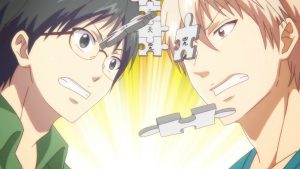 Koto clubs may be 80-90% female (which makes Tokise an outlier) but there are other boys in their midst – and it’s Kiryuu who’s at the center of the B-part this week. If you don’t like backstories, Kono Oto may not be your jam – this series is the king of them. It all ties back to that matter of detail – if a character is significant, they get a dossier of their own. Kiryuu’s is that he was sickly as a child, and as such an outcast in the rambunctious world of boys. It wasn’t until future classmate Asano Izumi moved next door that his life began to change, as she took him under her wing and eventually got them both into the koto – because unlike soccer or baseball, koto was something Kiryuu could actually play.
Koto clubs may be 80-90% female (which makes Tokise an outlier) but there are other boys in their midst – and it’s Kiryuu who’s at the center of the B-part this week. If you don’t like backstories, Kono Oto may not be your jam – this series is the king of them. It all ties back to that matter of detail – if a character is significant, they get a dossier of their own. Kiryuu’s is that he was sickly as a child, and as such an outcast in the rambunctious world of boys. It wasn’t until future classmate Asano Izumi moved next door that his life began to change, as she took him under her wing and eventually got them both into the koto – because unlike soccer or baseball, koto was something Kiryuu could actually play.
 As is made clear in Meiryou’s performance of “Hyakkafu” (a sort of mini “Four Seasons” for koto), Kiryuu is the spine and heart of the Meiryou koto club. His solos are one thing (idiosyncratic and challenging) but it’s his role in shaping the ensemble’s overall sound where he really shines (and Satowa notes that this is a skill she’s not mastered herself). It only makes sense that a larger group would have a harder time meshing as a unit, but under Kiryuu (who’s the de facto coach of the group) Meiryou manages to do so. It’s not hard to guess that Kiryuu’s flip behavior is a front – he’s actually in perpetual fear that his one connection to other people will be taken away from him. But whatever brings you to your art, once you get there it’s all about channeling that urgency into your own artistic vision – something Tokise is still in the training wheels stage of figuring out.
As is made clear in Meiryou’s performance of “Hyakkafu” (a sort of mini “Four Seasons” for koto), Kiryuu is the spine and heart of the Meiryou koto club. His solos are one thing (idiosyncratic and challenging) but it’s his role in shaping the ensemble’s overall sound where he really shines (and Satowa notes that this is a skill she’s not mastered herself). It only makes sense that a larger group would have a harder time meshing as a unit, but under Kiryuu (who’s the de facto coach of the group) Meiryou manages to do so. It’s not hard to guess that Kiryuu’s flip behavior is a front – he’s actually in perpetual fear that his one connection to other people will be taken away from him. But whatever brings you to your art, once you get there it’s all about channeling that urgency into your own artistic vision – something Tokise is still in the training wheels stage of figuring out.














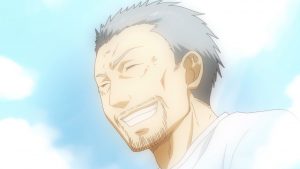

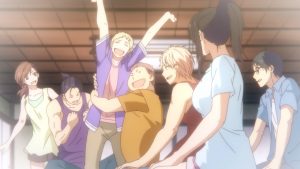


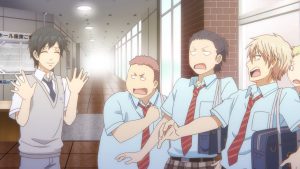











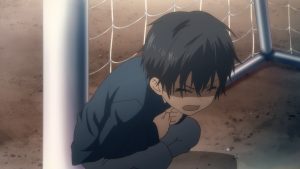






Snowball
June 16, 2019 at 10:32 pmPersonally, I don’t mind backstories of minor characters as long as I am becoming invested in such characters, however, I don’t feel that Kiriyuu is a compelling character yet so his backstory being presented here came across as bad timing. I’m liking the increase in koto performances though.
Earthlingzing
June 17, 2019 at 12:34 amThe slight problem I have is that so many of the cast have similarly depressing backstories. It worked at the start, but right now the darkness is starting to feel a little samey and as a result I’m finding Kiryuu a bit of a drag.